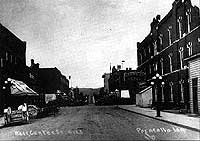|
Page
116
|


|
||
 |
||
| View looking east at the Pacific Hotel in the middle of the railroad tracks, taken from the corner of Arthur and West Center, about 1894. Note the covered wagon. The Cook Building is the stone structure with the turrets on the south side of West Center. Maag Drug occupies this building in 1996. The short peaked steeple on the north side of the road is the Congregational Church with its bell, the first church bell in Pocatello, installed in about 1890. Photo from Abe Lillibridge collection, Idaho State University. | ||
 |
||
| View looking east from the 400 Block of West Center Street from near the Arthur Street intersection, downtown Pocatello, about 1916. This picture is taken about one block west of the one above; note the north end of the Pacific Hotel has been removed to allow construction of the Center Street viaduct. The original Bannock Hotel is on the right. The second, seven-story hotel that became a city landmark, was torn down in 1982. Simplot Square now occupies the spot. Note Center Street viaduct, built in 1911 and replaced with the present subway in 1934. The newly constructed Kane Building is the light-colored stone structure on the south side of the 300 Block of West Center. Photo from Abe Lillibridge collection, Idaho State University. |
Also included in the 1888 Act of Congress were almost 50 acres for a reservoir and pipeline from City Creek to the railroad right of way. This right-of-way reverted to the U.S. Government in 1992, and a parkway, connecting downtown with the Portneuf Greenway system was constructed, starting in 1996.
Surrounding the railroad premises was the townsite of Pocatello, consisting of 1,840 acres, less the land occupied by the railroads. The townsite plat contained no park land and did not acknowledge that the Portneuf River meandered through its flood plain in the middle of town. The river is not indicated on the plat. The individual lots contained in the townsite were surveyed and sold at public auction in 1891, though it was understood that persons already in possession were to have first choice. Under the 1888 Act, lots not sold at auction became part of the public domain, subject to purchase by the public. Accordingly, permanent buildings began to be erected throughout the townsite prior to the 1891 auction. Photographs of downtown Pocatello taken in 1889 show many large, permanent buildings. Even after the auction, there was an almost immediate need for the new town to expand, but it could not because the lands surrounding the townsite were reservation property.
Reduction
of Area of the Fort Hall Indian Reservation
The original Fort
Hall Reservation had approximately 1,500,000 acres; the first reduction was
contained in a treaty entered into between the Indians and the government in
1880 but not ratified by Congress until February 23, 1889, restoring the southern
one-third of the reservation to the public domain.
The Oregon Short Line right of way was sold in 1882. Pocatello townsite and the Utah & Northern right of way were removed in 1888. The next major reduction was by an 1898 treaty, which was ratified in 1900, removing the middle third of the Reservation upon proclamation by the president. This proclamation was issued by President Theodore Roosevelt in 1902, causing a land rush in the area surrounding Pocatello and south to McCammon.